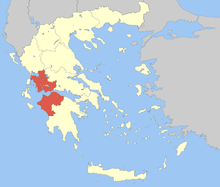Missolonghi
Missolonghi (Greek: Μεσολόγγι, pronounced [mesoˈloɲɟi]) or Messolonghi is a municipality of 34,416 people (according to the 2011 census)[1] in western Greece. The town is the capital of Aetolia-Acarnania regional unit, and the seat of the municipality of Iera Polis Messolongiou (Sacred Town of Messolonghi). Missolonghi is known as the site of a dramatic siege during the Greek War of Independence, and of the death of poet Lord Byron.
Missolonghi Μεσολόγγι | |
|---|---|
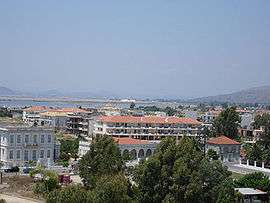 View of the west part of the town | |
 Seal | |
 Missolonghi Location within the region 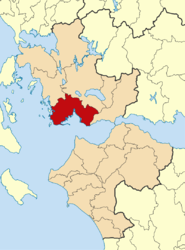 | |
| Coordinates: 38°23′N 21°26′E | |
| Country | Greece |
| Administrative region | West Greece |
| Regional unit | Aetolia-Acarnania |
| Government | |
| • Mayor | Kostas Lyros |
| Area | |
| • Municipality | 680.4 km2 (262.7 sq mi) |
| • Municipal unit | 280.2 km2 (108.2 sq mi) |
| Elevation | 5 m (16 ft) |
| Highest elevation | 9 m (30 ft) |
| Lowest elevation | 0 m (0 ft) |
| Population (2011)[1] | |
| • Municipality | 34,416 |
| • Municipality density | 51/km2 (130/sq mi) |
| • Municipal unit | 18,482 |
| • Municipal unit density | 66/km2 (170/sq mi) |
| Time zone | UTC+2 (EET) |
| • Summer (DST) | UTC+3 (EEST) |
| Postal code | 302 00 |
| Area code(s) | 26310 |
| Vehicle registration | ΜΕ |
| Website | www.messolonghi.gov.gr |
Geography
The town is located between the Achelous and the Evinos rivers and has a port on the Gulf of Patras. It trades in fish, wine, and tobacco. The Arakynthos mountains lie to the northeast. The town is almost canalized but houses are within the gulf and the swamplands. The Messolonghi-Etoliko Lagoons complex lies to the west. In the ancient times, the land was part of the gulf.
Climate
Summers are long, hot and humid, with temperatures often surpassing 40 °C and remaining above 25 °C even at night. Winters are short and mild with frequent rainfalls.
Transport
National Transport
The new Greek National Motorway 5 (Ionia Odos) passes north of Missolonghi.
The town had a railway station on the Hellenic Railways Organisation line from Krioneri to Agrinio but this has been abandoned since the 1970s.
The Intercity Buses Of Aitoloakarnania[2] also have service towards Agrinio, Amfiloxia, Astakos, Volos, Vonitsa, Thessaloniki, Lamia, Larisa, Livadia, Mitikas, Patras, Chalkida and the capital Athens.
The local airport has a hard runway but no scheduled services. The closest airport with scheduled services is Aktion National Airport just an hour and half away.
Two new ferry connections towards Zakynthos, Cephalonia, and Ithaca are to be launched by the next summer season (2019 - 2020).
Administration
The municipality Missolonghi (official name: Greek: Δήμος Ιεράς Πόλεως Μεσολογγίου) was formed at the 2011 local government reform by the merger of the following 3 former municipalities, that became municipal units:[3]
The municipal unit Missolonghi is subdivided into 8 communities:
- Agios Georgios
- Agios Thomas
- Ano Koudouni
- Ellinika
- Evinochori
- Missolonghi
- Mousoura
- Retsina
The municipality has an area of 680.372 km2, the municipal unit 280.168 km2.[4]
Province
The province of Missolonghi (Greek: Επαρχία Μεσολογγίου) was one of the provinces of the Aetolia-Acarnania Prefecture. Its territory corresponded with that of the current municipality Missolonghi (except part of the municipal unit Oiniades) and the municipal units Angelokastro, Arakynthos and Makryneia.[5] It was abolished in 2006.
History
Missolonghi was first mentioned by a Venetian called Paruta when he was describing the naval Battle of Lepanto near Nafpaktos. According to predominant historical opinion, its name came from the combination of two Italian words, mezzo and laghi which means "in the middle of lakes" or messo and laghi (Messolaghi) which means "a place surrounded by lakes". Until 1700, Missolonghi was under Venetian domination. Its inhabitants were mostly fishermen. They lived in cabins which were made of a kind of waterproof straw and reed and stood on stilts above sea water. These cabins or stilt-houses have always been called "pelades". Missolonghi was part of Aetolia until the late-1820s when was Aetolia-Acarnania created.
North-west of Missolonghi are the remains of Pleuron ('Asfakovouni'), a town mentioned in Homer's works. It participated in the Trojan expedition and was destroyed in 234 BC by Demetrius II Aetolicus. The new town, which was built on the remains of old Pleuron, was one of the most important towns in Aitolia. Its monumental fortification comprised thirty towers and seven gates. The remains of the theatre and an enormous water tank with four compartments still exist.
Greek War of Independence
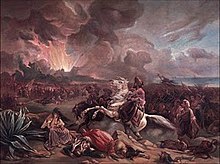
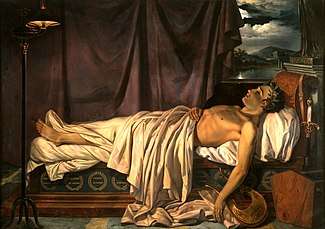
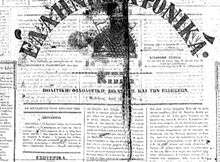
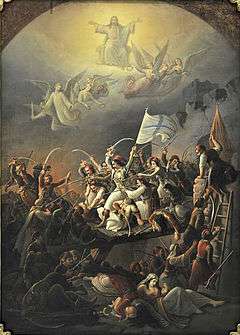
During the Orlov Revolt in 1770 the fleet of Missolonghi was defeated and the town passed to the Ottomans. Missolonghi revolted on 20 May 1821 and was a major stronghold of the Greek rebels in the Greek War of Independence, being the seat of the Senate of Western Continental Greece. Its inhabitants successfully resisted a siege by Ottoman forces in 1822.[6] The second siege started on 15 April 1825[6] by Reşid Mehmed Pasha whose army numbered 30,000 men and was later reinforced by another 10,000 men led by Ibrahim Pasha, son of Muhammad Ali Pasha of Egypt. After a year of relentless enemy attacks and facing starvation, the people of Missolonghi decided to leave the beleaguered city in the "Exodus of its Guards" (The Sortie) on the night of 10 April 1826. At the time, there were 10,500 people in Missolonghi, 3,500 of whom were armed. Very few people survived the Ottoman pincer movement after the betrayal of their plan.
Due to the heroic stance of the population and the subsequent massacre of its inhabitants by the Turkish-Egyptian forces, the town of Missolonghi received the honorary title of Hiera Polis (the Sacred City), unique among other Greek cities. The famous British poet and philhellene Lord Byron, who supported the Greek struggle for independence, died in Missolonghi in 1824. He is commemorated by a cenotaph,[6] containing his heart,[7] and a statue located in the town.[6]
Modern era
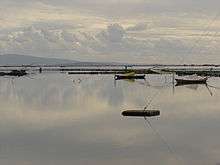
The town itself is very picturesque but also modern with functional, regular urban planning. Some very interesting buildings representative of traditional architecture can be seen here. People whose names were related to modern Greek history once lived in some of them. The mansion of the Trikoupis family, Palamas' House, Valvios Library, Christos and Sophia Moschandreou Gallery of Modern Art emphasize the fact that Missolonghi has always been a city of some wealth and refinement. In addition, the Centre of Culture and Art, Diexodos, which hosts cultural events and exhibitions as well as the Museum of History and Art is housed in a neo-classical building in Markos Botsaris Square and hosts a collection of paintings indicative of the struggle of Missolonghi, further boosting the city's cultural and artistic profile. The Messolonghi Byron Society also, founded in 1991 in the city, is a non profit organisation which is devoted to promoting scholarly and general understanding of Lord Byron's life and poetry as well as cultivating appreciation for other historical figures in the 19th-century international Philhellenic movement, idealists who, like Byron, gave their fortunes, talents, and lives for the cause of Greek War of Independence. The Messolonghi Byron Center is now located in the upper floor of Byron House.
Today, the Entrance Gate remains intact and so does part of the fortification of the Free Besieged which was rebuilt by King Otto. Past the gate, there is the Garden of Heroes where several famous and some anonymous heroes who fought during the Heroic Sortie are buried. The Garden of Heroes is the equivalent of the Elysian Fields for modern Greece. Every year the Memorial Day for the Exodus is celebrated on Palm Sunday (the Sunday before Easter); the Greek State is represented by high-ranking officials and foreign countries by their ambassadors.
Media
Landmarks
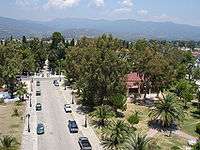
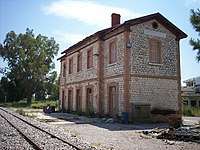
Notable people
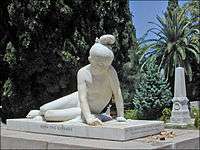
- Lord Byron died here in 1824 and is commemorated by a cenotaph and a statue[6]
- Epameinontas Deligeorgis (1829–1879), former Prime Minister of Greece
- John Lykoudis (1910–1980), major and medical doctor involved in the treatment of peptic ulcer disease
- Miltiadis Malakasis (1869–1943), poet
- Spyros Moustaklis, Army officer, democracy activist during the junta
- Thanasoulas Valtinos (1801 or 1802-1870 or 1877), revolutionary of the Greek War of Independence
- Kostis Palamas (1859–1943), Greek poet, co-author of the Olympic Hymn
- Anastasios Papoulas (1859–1935), Greek general and commander-in-chief in the Greco-Turkish War (1919–1922)
- Antonis Travlantonis (1895–1896), Greek educator, former director of Zosimaia School
- Charilaos Trikoupis (1832–1896), Prime Minister of Greece
- Nikolaos Trikoupis (1869–1956), Greek general
- Spyridon Trikoupis (1788–1873), Prime Minister of Greece, father of Charilaos Trikoupis
- Charalambos Tseroulis (1879–1929), Greek general
- Dimitrios Valvis (1814–1886), Prime Minister of Greece
- Zinovios Valvis (1800–1872), Prime Minister of Greece
- Sperantza Vrana (1926–2009), actress
Historical population
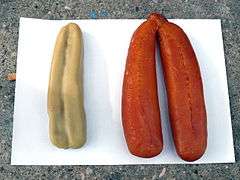
| Year | City | Municipal unit | Municipality |
|---|---|---|---|
| 1981 | 11,375 | - | - |
| 1991 | 10,916 | 16,859 | - |
| 2001 | 13,791 | 17,988 | - |
| 2011 | 14,386 | 18,482 | 34,416 |
International relations
Twin towns—sister cities
Missolonghi is twinned with:
|
References
- "Απογραφή Πληθυσμού - Κατοικιών 2011. ΜΟΝΙΜΟΣ Πληθυσμός" (in Greek). Hellenic Statistical Authority.
- http://www.ktel-aitolnias.gr/el/
- Kallikratis law Greece Ministry of Interior (in Greek)
- "Population & housing census 2001 (incl. area and average elevation)" (PDF) (in Greek). National Statistical Service of Greece. Archived from the original (PDF) on 2015-09-21.
- "Detailed census results 1991" (PDF). Archived from the original (PDF) on 2016-03-03. (39 MB) (in Greek and French)
- Chisholm, Hugh, ed. (1911). . Encyclopædia Britannica. 18 (11th ed.). Cambridge University Press. p. 607.
-

External links
| Wikimedia Commons has media related to Municipality of Missolonghi. |
| Wikisource has the text of the 1879 American Cyclopædia article Missolonghi. |
- Cultural Centre Of Messolonghi (in Greek)
- Municipality of Messolonghi (in Greek)
- Information about Mrssolonghi (in English)
- News from Messolongi (in Greek)
- Messolonghi Travel and Business Guide (in Greek)
- The Acheloos delta forms the Messolongi Lagoon
- Sights and Activities in Messolongi
